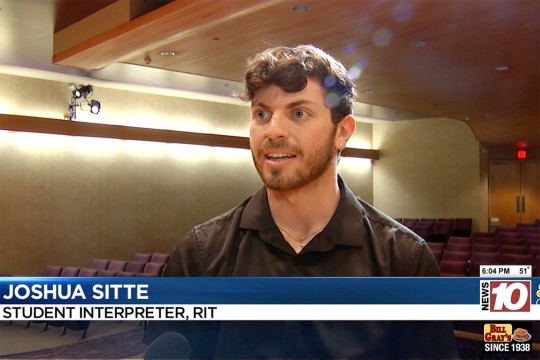Photo alumnus realizes dream of MoMA exhibit
Willie Osterman
Several hundred invited guests enjoyed the retrospective of work by Walid Raad ’89 at New York City’s Museum of Modern Art.
Willie Osterman still recalls the time in the mid-1980s when— as is the RIT photography professor’s custom every year—he asked his introductory photography students where they wanted to be in 10 years or so.
“Without hesitation from the middle of the room a hand went up and Walid Raad said he was going to have a solo show at the Museum of Modern Art (MoMA),” recalled Osterman, the fine art photography program chair in the School of Photographic Arts and Sciences.
Sure enough, MoMA recently presented the first comprehensive American survey of Raad ’89 (professional photographic illustration) featuring his work in photography, video, sculpture and performance from the last 25 years.
Raad’s work is informed by his upbringing in Lebanon during the civil war (1975–91), and by the socioeconomic and military policies that have shaped the Middle East in the past few decades.
“I am drawn to how events of extreme violence—physical and psychological—are lived and experienced,” Raad said. “I try to engage the forms, gestures and concepts that are made possible by such events.”
The solo exhibition, which encompassed two floors of MoMA while highlighting a wide variety of Raad’s conceptual work, ended in January. It focused on two of his long-term projects: The Atlas Group (1989–2004) and Scratching on things I could disavow (2007–ongoing). Under the rubric of The Atlas Group, a 15-year project exploring the contemporary history of Lebanon, Raad produced fictionalized photographs, videotapes, notebooks and lectures that related to real events and authentic research in audio, film and photographic archives in Lebanon and elsewhere.
His recent work has expanded to address the Middle East region at large. Raad’s current ongoing project, Scratching on things I could disavow, examines the recent emergence in the Arab world of new infrastructure for the visual arts—art fairs, biennials, museums and galleries—alongside the geopolitical, economic and military conflicts that have consumed the region. The show moves to Boston and Mexico City this year.
Raad developed his affection for photography in his early years. “Growing up during the war years, there were so many photojournalists around,” he recalled. “The camera was my excuse to go to places in Beirut that I would never have dared to visit without one.”
Last fall, Raad invited Osterman to a private reception at MoMA as the exhibit neared. When the two saw each other, Raad excused himself from well-wishers and ran over to thank his former professor. “Anyone who teaches knows that this is the highest compliment to receive,” Osterman said.















